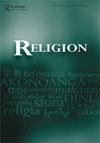The pluralistic notion of zvipuka : Shona indigenous knowledge and human and nonhuman animal interaction in Zimbabwe
IF 1
2区 哲学
0 RELIGION
引用次数: 0
Abstract
ABSTRACTThe article analyses zvipuka (human and nonhuman animals) interaction discourses in order to draw attention to the contribution Shona indigenous knowledge provides towards understanding zvipuka interactions. From largely an Afrocentric perspective, blended with selected tenets of Critical Animal Studies (CAS) theory, the study interrogates Shona cultural beliefs, values and practices to reveal the knowledge that shapes people's attitudes towards animals.This approach diverts from the traditional Eurocentric and often binarised conception of animals and African peoples through discourses of Othering. There is no single conception of the same chipuka (creature/animal) as either good or bad in Shona culture by virtue of the various religious and socioeconomic contexts in which zvipuka discourses are articulated. It is therefore argued that from an African epistemological standpoint, there is a general positive pluralistic notion of nonhuman animals in Zimbabwe, knowledge that can be utilised in formulating sustainable policies for protecting and conserving nonhuman animals.KEYWORDS: Animal embodimentsShona cultureAfrican Indigenous Knowledge Systems (AIKS)AfrocentricityEurocentrismanimal conservation Disclosure statementNo potential conflict of interest was reported by the author(s).Notes1 However, it should be noted that nonhuman animals are also complex bio-psycho-social beings not just the instinctual automata that the mainstream Western tradition thought them to be.2 The UN Department of Economic and Social Affairs recognises the role IKS can play in the realization of Sustainable Development Goals. It states that ’Indigenous Knowledge Systems are being recognized as inherently encompassing most of the aspects and principles of SDGs’. See https://sdgs.un.org/partnerships/integrating-indigenous-knowledge-systems-2030-un-sustainable-development-goals.3 https://www.britannica.com/place/Africa/Animal-life.4 This is a human spirit of divination seen as a good spirit by its owner who uses it to recover wealth and stolen property but believed to be an evil spirit used to create wealth through harming and killing one’s blood relatives.5 This is a traditional religious dance found in central and southern Zimbabwe, associated with the worship of Mwari.6 ZANLA was the military wing of the Zimbabwe African National Union (ZANU), the Shona-based and main nationalist party in the struggle for independence in Zimbabwe.7 This is the Acholi name for the African green broadbill.8 For more details, refer to the website, ZimFieldGuide.com. https://zimfieldguide.com/mashonaland-west/operation-noah-memorial.9 The Zambezi River is an important tenet of Tonga religion; the Tonga people believe that in it resides the serpentine river god, Nyami-nyami, which provides fisherman with abundant fish. However, as the legend goes, the construction of the Kariba dam wall separated Nyami-Nyami from his wife. The challenges of relocation still encountered by the Tonga people today are still explained in terms of this tragedy of dam construction and massive human and nonhuman animal relocation.Additional informationNotes on contributorsMickias MusiyiwaMickias Musiyiwa (PhD, Stellenbosch University, South Africa) is an Associate Professor at the University of Zimbabwe. He teaches African Indigenous Knowledge Systems (AIKS), heritage studies, digital humanities and strategic studies. He has published many articles in peer-reviewed journals and book chapters in these disciplines and sub-disciplines.zvipuka的多元概念:津巴布韦Shona土著知识和人类与非人类动物的相互作用
摘要本文通过对人类与非人类动物互动话语的分析,关注修那土著知识对理解人类与非人类动物互动的贡献。该研究主要从非洲中心主义的角度出发,结合批判动物研究(CAS)理论的若干原则,对修纳人的文化信仰、价值观和实践进行了探讨,以揭示影响人们对动物态度的知识。这种方法偏离了传统的以欧洲为中心,通过他者的话语将动物和非洲人民二元化的概念。在修纳文化中,由于zvipuka话语的不同宗教和社会经济背景,并没有单一的概念将相同的chipuka(生物/动物)定义为好或坏。因此,有人认为,从非洲认识论的角度来看,津巴布韦对非人类动物有一个普遍的积极的多元概念,这些知识可以用于制定保护和保存非人类动物的可持续政策。关键词:动物形体;绍纳文化;非洲土著知识系统(AIKS);非洲中心主义;注1然而,应该指出的是,非人类动物也是复杂的生物-心理-社会生物,而不仅仅是西方主流传统所认为的本能自动机联合国经济和社会事务部认识到IKS在实现可持续发展目标方面可以发挥的作用。它指出,“土著知识系统被认为内在地包含了可持续发展目标的大多数方面和原则”。参见https://sdgs.un.org/partnerships/integrating-indigenous-knowledge-systems-2030-un-sustainable-development-goals.3 https://www.britannica.com/place/Africa/Animal-life.4这是一种人类的占卜精神,被它的主人视为一种好精神,用它来追回财富和被盗的财产,但被认为是一种邪恶的精神,用来通过伤害和杀害自己的血亲来创造财富这是在津巴布韦中部和南部发现的一种传统的宗教舞蹈,与对姆瓦里的崇拜有关。ZANLA是津巴布韦非洲民族联盟(ZANU)的军事分支,ZANU是津巴布韦争取独立的主要民族主义政党,以肖纳为基地欲了解更多详情,请参阅ZimFieldGuide.com网站。https://zimfieldguide.com/mashonaland-west/operation-noah-memorial.9赞比西河是汤加宗教的重要信条;汤加人相信蛇形的河神Nyami-nyami住在里面,他给渔民提供丰富的鱼。然而,正如传说中所说,卡里巴大坝的修建将尼亚米-尼亚米和他的妻子分开了。汤加人民今天仍然遇到的重新安置的挑战仍然用大坝建设和大规模人类和非人类动物重新安置的悲剧来解释。amickias Musiyiwa(博士,Stellenbosch大学,南非)是津巴布韦大学的副教授。他教授非洲土著知识系统(AIKS)、遗产研究、数字人文和战略研究。他在这些学科和子学科的同行评审期刊和书籍章节中发表了许多文章。
本文章由计算机程序翻译,如有差异,请以英文原文为准。
求助全文
约1分钟内获得全文
求助全文
来源期刊

RELIGION
RELIGION-
CiteScore
2.70
自引率
0.00%
发文量
58
期刊介绍:
RELIGION is an internationally recognized peer-reviewed journal, publishing original scholarly research in the comparative and interdisciplinary study of religion. It is published four times annually: two regular issues; and two special issues (or forums) on focused topics, generally under the direction of guest editors. RELIGION is committed to the publication of significant, novel research, review symposia and responses, and survey articles of specific fields and national contributions to scholarship. In addition, the journal includes book reviews and discussions of important venues for the publication of scholarly work in the study of religion.
 求助内容:
求助内容: 应助结果提醒方式:
应助结果提醒方式:


